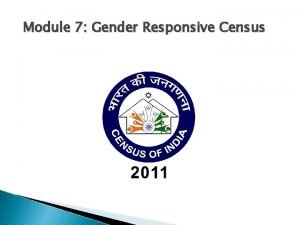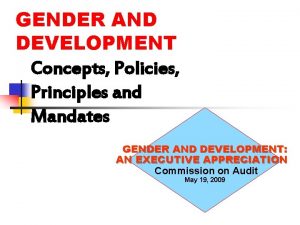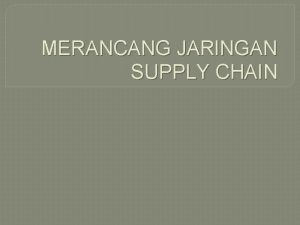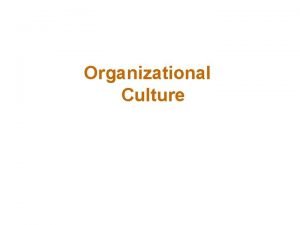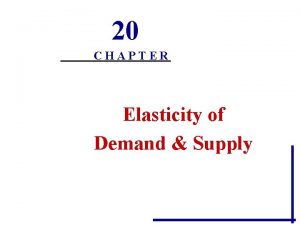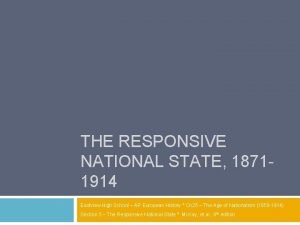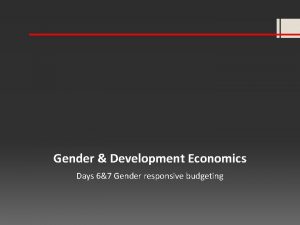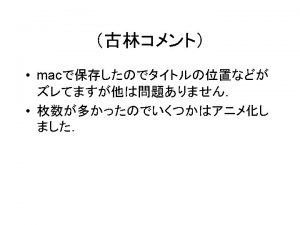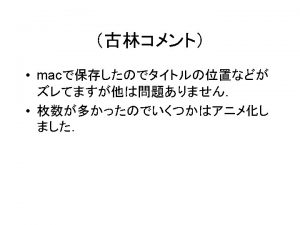GENDER RESPONSIVE ME Ngonidzaishe Marimo Key Concepts What





































- Slides: 37

GENDER RESPONSIVE M&E Ngonidzaishe Marimo

Key Concepts What is equity? Equity focused monitoring and evaluation? What is Gender Mainstreaming? What is Gender analysis

Key concepts Gender is a socio-cultural variable that refers to the comparative, relational or differential roles, responsibilities, and activities of females and males � Whereas the sex of men and women is biologicallydetermined, gender roles are socially constructed � Gender concerns power relationships between women and men. Gender equality refers to the enjoyment of equal rights, opportunities and treatment by women and men, and girls and boys, in all spheres throughout their lives

Key Concepts People’s rights, responsibilities, status and access to and control over resources and benefits should not depend on whether they are born male or female � How - using a gender mainstreaming strategy? Gender mainstreaming means the systematic identification and consideration of gender issues in any kind of intervention at every step Gender mainstreaming recognizes that gender roles affect and are affected by any project, programme and policy dealing in the social, political or economic realm.

Key Concepts Mainstreaming Gender has two elements: Analytical - geared towards understanding power relations between men and women � Normative - geared towards creating more gender equality so that women and men have equitable access and control of productive resources and benefits � Monitoring and evaluation support these two components By systematically analysing the effects an intervention has on power relations between men and women, and on the goal of creating more gender equality � By recommending actions to improve the effectiveness of an intervention to address the different needs of women and to contribute to greater gender equality �

Key Concepts What is Gender analysis? � is closely linked to the quality control of an intervention by ensuring that it adequately considers gender concerns throughout its planning and implementation, regardless of whether the intervention explicitly targets the empowerment of women or gender equality � Not adequately addressing gender concerns has shown negative repercussions on the relevance, effectiveness and sustainability of an intervention � It can also reinforce unequal power relations between men and women can exacerbate this and diminish women’s status

Key Concepts Example: � For example, if a project aims at extending social protection coverage and it is known that 70 per cent of the population not covered by social protection is female, it would not achieve results if it mainly reaches men (besides being unacceptable from an equality point of view).

Key Concepts Gender analysis requires: � Sex-disaggregated data — If no sexdisaggregated information is available, it should be generated. � Mixed methods — The use of both quantitative and qualitative information. Quantitative information helps to compare; qualitative information helps to capture the more complex and less quantifiable causes and effects of gender inequality.

Selecting Gender Sensitive Indicators A GENDER INDICATOR provides "direct evidence of the status of women, relative to some agreed normative standard or explicit reference group” A GENDER INDICATOR can be defined as using quantitative and qualitative measures to capture gender-related changes in society over time. GENDER INDICATORS need to track changes in women’s empowerment and in gender equality Four types of gender responsive indicators: Sex disaggregated � Gender specific � Implicitly gendered � Chosen by women �

Selecting Gender Sensitive Indicators Sex disaggregated: The value of the indicator is calculated separately for men and women, and so allows comparisons to be made between the two groups � Ratio of voter turnout among men to that of voter turnout among women. Gender specific: This group of indicators measures practices which are specifically targeted at women or men. In practice, it is likely to be made up largely of the inputs, outputs and outcomes of policies designed to increase women’s empowerment. � Proportion of seats in National Parliament reserved for women (%).

Selecting Gender Sensitive Indicators Implicitly gendered: In this case, the indicator makes no explicit reference to gender. However, if it is interpreted within a broader context, it is clear that the indicator is of particular relevance to women or men. Number and proportion (%) of reported rape cases prosecuted in courts (victims almost exclusively female); Number and proportion (%) of reported cases of domestic violence prosecuted in courts (victims predominantly female). Chosen by women: These two groups of indicators need not refer to gender at all. They may simply reflect differences in men’s and women’s preferences and priorities regarding different areas of governance � Percentage of women who say that they receive adequate information from the government on policies and laws that affect them.

Selecting Gender Sensitive Indicators Quantitative indicators: measures of quantity, such as the number of women users in a telecentre, the number of women trained in computer skills or the number of women who have access to the internet compared to men. Qualitative indicators: people’s judgments and perceptions on a subject, such as the confidence gained from acquiring computer skills � Qualitative gender indicators include collecting data of women’s own perceptions of a project’s impact and discovering how an intervention changed conditions of gender inequality. Selection of gender responsive indicators should measure: � Resources � Participation of women � Who has access to or control over resources? How and when do women and men participate in realising the benefits that they may or may not have control of? Benefits accruing to women What factors (e. g. social, political, cultural, economic) control access to benefits?

Challenges in Gender Responsive Monitoring and Evaluation Conventional monitoring and evaluation (M&E) systems that are gender-blind do not capture gender differences in access and impacts. � This is often due to the assumed “gender neutrality” of M&E methods and processes Another reason is that staff preparing monitoring plans, evaluation terms of reference or conducting monitoring and evaluation may lack awareness of gender issues. Women are also often under-represented in evaluation and interview teams, which may prevent some interviewed women from expressing themselves freely.

Challenges in Gender Responsive Monitoring and Evaluation Obtaining information from both women and men may increase the cost and time of data collection. This needs to be considered but is often neglected during the planning and budgeting of the M&E exercise.

Integrating Gender in Monitoring Systems The M&E system is based on the outcomes and indicators in the project document If the project document is gender-blind, the M&E system can – and should – refine and improve indicators to make them more gender-responsive To integrate gender equality issues into a monitoring and evaluation system, the following methodologies should be integrated: � � � Gender analysis Disaggregation of various stakeholder groups: Data should be collected in a disaggregated manner (e. g. by sex, ethnicity, age etc. ). Mixed Methods approach: an appropriate mix of qualitative and quantitative methods to gather and analyse data. This includes, and is not limited to: desk review, interviews, focus groups, surveys, etc.

Engendering Institutional Structures for M&E National M&E Framework institutional structure should include gender mainstreaming and other affirmative groups e. g. Kenya National and Gender Equality Commission has been involved in the national M&E system M&E framework should provide specific reference to support for gender responsive and equity focused information Explicit for training and capacity building on gender responsive and equity focused M&E among institutional structure members.

Exercise Review the Zimbabwe National M&E Policy for Gender Responsiveness http: //www. zes. org. zw/downloads/Zimb abwe%20 National%20 Monitoring%20 a nd%20 Evaluation%20 Policy. pdf Are there an improvements that can be made to the policy to ensure gender responsiveness and equity focused?

Exercise Please review the two Executive Summaries provided. � Do they provide information on gender responsiveness of the programmes? � Does the methodology reflect a gender responsive evaluation? � Note the challenges and how these could be improved?

Gender Responsive Evaluation The government of Zimbabwe is signatory to: � � Convention on the Elimination of All Forms of Violence Against Women Beijing Platform for Action SADC Gender Protocol Many other international and regional frameworks For an evaluation to be gender responsive, it is guided by these normative agreements Promotes accountability to GE, human rights ad women empowerment commitments by providing information on how development programs are affecting women and men differently and contributing towards achieve of these commitments. Applicable to all types of development programing, not just gender specific work Help promote social change by using knowledge from evaluation to improve development programming that promote GE, human rights and women’s empowerment

Definition of Gender Responsive Evaluation A systematic and impartial assessment that provides credible and reliable evidence-based information about the extent to which an intervention has resulted in progress (or lack thereof) towards intended and unintended results regarding gender equality and the empowerment of women. This evaluation incorporates gender equality and women’s rights dimensions into evaluation approaches, methods, processes and use. Not only focus on positive results for GEWE but also the process should empower the involved stakeholders and can prevent further discrimination.

What makes an evaluation gender responsive Two elements which are: � what the evaluation examines: assess the degree to which gender and power relationships – including structural and other causes that give rise to inequalities, discrimination and unfair power relations, change as a result of an intervention � How the evaluation is undertaken – using inclusive and participatory processes and respectful of all stakeholders (rights holders and duty bearers).

Key Principles of Gender Responsive Evaluation Independence and impartiality – evaluation should be free from any influence especially by management and unbiased reports should be produced. e. g. a Program manager who has been managing the program being evaluated should not manage the evaluation. Transparency – evaluation should be conducted in a transparency and consultative manner with stakeholders Quality and credibility – conduct an evaluation in a systematic using sound approaches and methods. Intentionality and use of evaluation – purpose of evaluation and its use should be clear at the planning stage

Key Principles of Gender Responsive Evaluation National ownership and leadership – evaluation should be country driven and respond to the needs of duty bearers and rights holders. Innovation – evaluation seek to identify and highlight innovative approaches to GEWE. Fair power relations and empowerment contextual power and gender relations should be understood. Creation of knowledge through a participatory process with all stakeholders Participation and inclusion – evaluation should promote participation of stakeholders through the evaluation process

Strategic Intent of Gender Responsive Budgeting Results and accountability – provide information to stakeholders on processes and intended and unintended effects of programs on women’s empowerment, gender equality and human rights Evidence for decision making – to influence program design, implementation and resource allocation and providing information about participants and stakeholders’ needs Lesson learned – document what is working well, what is not and what this means for the program and for other development efforts in relation to GE, human rights and empowerment of women.

Managing Gender Responsive Evaluation Planning Preparatio n Conduct Use and follow up Reporting

Managing Gender Responsive Evaluation: Planning and preparation stage Appoint Evaluation Manager Evaluability Assessment Stakeholder analysis and engagement Select Evaluation Team Develop TOR

Managing Gender Responsive Evaluation: Evaluability assessment A systematic process intended to determine whether or not an intervention is a condition to be evaluated, justified, feasible and likely to provide useful information. Helps prepare a program for an evaluation Gender equality and human rights considerations – all EA should examine if human rights and GE are integrated into the intervention Focuses on: analysis of Theory of Change; existence and availability of relevant information, Conduciveness of the context and Accountability – clarity and understanding on structure, monitoring reporting, ownership and leadership.

Managing Gender Responsive Evaluation: Stakeholder analysis Include both women and vulnerable groups Key questions for identifying stakeholders Who: stakeholders should be disaggregated as appropriate What is their role in the intervention Why – what are the gains from involving them Priority: importance of involvement in the evaluation process When – at what stage to involve them How: ways and capacities in which stakeholders will participate

Managing Gender Responsive Evaluation: Stakeholder engagement Evaluation should clearly define and organisation and management structure and establish roles and responsibilities of key stakeholders Management group: Oversee the evaluation process and should be coordinated by the evaluation manager Responsibility for final approval of TORs, selection of the external evaluator, inception report, draft reports, final report Made up: senior management, evaluation manager, program Officer responsible for the program being evaluated, M & E Officers

Managing Gender Responsive Evaluation: Stakeholder engagement Reference group: Use stakeholder analysis to identify the key stakeholders for the Reference group Role can vary including: decision making; providing contextual or technical expertise and supporting evaluation dissemination and use; implementing evaluation recommendations TORs to outline main roles and responsibilities Limiting number may promote efficient management of the evaluation

Managing Gender Responsive Evaluation: Developing TORs Key componets of the To. R: Background; description of the programme; purpose and use of evaluation; scope of evaluation; evaluation design (process and methods); Stakeholder participation; timeframe; expected deliverables; management of the evaluation; evaluation team composition and ethical code of conduct

Evaluation: Developing TORs – Gender Responsive evaluation methods Use gender analysis framework (e. g. Harvard analytical framework, gender planning framework, social relations framework, women’s empowerment framework etc. ) Draw upon feminist theory and methodologies Methods should be relevant to both women and men Methods should be participatory Ensure collection of sex disaggregated data Explore gender roles and poor relations Methods are contextual and culturally sensitive Emphasize mixed methods (quantitative and qualitative) Ethical consideration

Managing Gender Responsive Evaluation: Selecting evaluation team Experience in conducting gender responsive evaluation Extensive experience in applying, qualitative and quantitative evaluation methods Experience in gender analysis and human rights based approaches

Conducting the evaluation Inception phase Managing the evaluation consultant or team Managing Management and Reference groups Gender equality and human rights considerations in reviewing reports

Reporting, disseminating and use of evaluation Quality assurance Stakeholder involvement in reviewing reportsDissemination – user friendly dissemination of information

Developing management response Participatory and all concerned stakeholders should be involved in developing a management response Implementation of the action plan / management response

Sources of information UN Women Evaluation Policy UN Women Evaluation Handbook: “How to manage gender-responsive Evaluation”. National evaluation policies for sustainable and equitable development – How to integrate gender equality and social equity in national evaluation policies and systems – un Women, Eval. Partner, IOCE in partnership with USAID, UNEG AND Ministry for Foreign Affairs, Finland.
 What is gender responsive pedagogy
What is gender responsive pedagogy Gender responsive census
Gender responsive census Strategic gender needs and practical gender needs
Strategic gender needs and practical gender needs Gender and development concepts
Gender and development concepts Example of a business model canvas
Example of a business model canvas Contoh bisnis model canvas makanan pdf
Contoh bisnis model canvas makanan pdf Plissitモデル
Plissitモデル Fluid responsive shock
Fluid responsive shock Java swing responsive gui
Java swing responsive gui Creating a customer responsive culture
Creating a customer responsive culture Responsive speaking tasks
Responsive speaking tasks Culturally responsive vs culturally relevant
Culturally responsive vs culturally relevant Checking a responsive person sample
Checking a responsive person sample Sophia abbasi
Sophia abbasi Basic types of speaking
Basic types of speaking Responsive reading for thanksgiving
Responsive reading for thanksgiving Responsive uis
Responsive uis Vdoe culturally responsive teaching
Vdoe culturally responsive teaching Jaringan supply chain
Jaringan supply chain Culturally responsive teaching and the brain book study
Culturally responsive teaching and the brain book study Responsive reading christmas
Responsive reading christmas Addressing competition and driving growth
Addressing competition and driving growth Responsive design final assessment
Responsive design final assessment Creating a customer responsive culture
Creating a customer responsive culture Culturally responsive teaching in music education
Culturally responsive teaching in music education Culturally responsive classroom management
Culturally responsive classroom management Chapter 2 socially responsive marketing
Chapter 2 socially responsive marketing Price elasticity of demand
Price elasticity of demand Responsive anticipation and creative anticipation
Responsive anticipation and creative anticipation Responsive prayer
Responsive prayer Reach associates
Reach associates Responsive national state
Responsive national state Dementia
Dementia School counseling responsive services
School counseling responsive services Zaretta hammond quotes
Zaretta hammond quotes Demand responsive transport
Demand responsive transport Responsive classroom youtube
Responsive classroom youtube Customer responsive culture
Customer responsive culture

